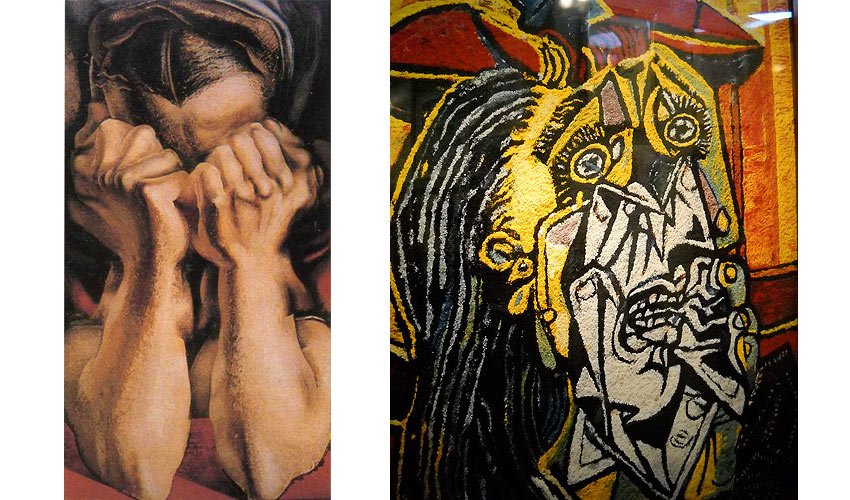Why are feelings and art so intimately related? Whether we are aware of it or not, every time we take up a pencil, dip a brush in paint, or start chipping away at a piece of rock or wood, we are producing emotional art. But what really goes through our minds when we’re working?
Throughout history, artists have tried a number of approaches to establish a connection with their listeners. Every piece of art aims to convey a message to the viewer as perceived from the artist’s perspective, whether that message is communicated by the use of particular colors, the depiction of particular scenes, or the communication of symbols that operate on a subconscious level.
Let’s examine a few situations where feelings and art interact :
Emotional Art And Symmetry
We’re hardwired to search out symmetry, which is why it’s a common motif in art. When our cave-dwelling ancestors had to make decisions about avoiding predators, pursuing prey, or choosing a spouse, they looked for symmetry—more specifically, bilateral symmetry. It follows that having the most symmetrical features is not surprising in some of the world’s most beautiful people.

Emotional Reactions to Art
All in all, most people’s responses to art are more nuanced than simple happiness or sadness. We have complex emotional connections with paintings, drawings, sculptures, and installations—what some psychiatrists refer to as “meta emotions.”
What are these precisely? They happen when several emotions are stirred up simultaneously. They appear when a work of art effectively conveys both technical mastery and complexity. These are the times when we are completely engrossed in the moving artwork that is on display. For instance, a masterfully painted picture of Christ on the cross will both satiate our need for symmetry and have a more profound emotional impact on us.
Think about what would occur if the Christ figure wasn’t as well portrayed; for example, if the anatomy was patently inaccurate. Will the same answer be given to it? No, studies indicate. It seems that everything needs to be perfectly combined for a piece of art to make us feel metaphysically. Ironically, though, this also applies to an immaculately rendered but unpassionate portrayal of something.
When you make art, what happens?
Making art along with others forges deep connections. You’re combining your technical proficiency with your personal thoughts and sentiments. You’re trying to relate your audience to your personal life experiences. Whether you realize it or not, you are producing emotionally charged work. You are using your subconscious mind when you choose your composition, subject matter, and color scheme.
Learning to translate and understand hidden emotions into art is a process that takes time. It’s all a part of the training process for artists. Sometimes people are not able to understand what you are trying to say able to develop and gain knowledge from patently inaccurate.
Expressionism
The goal of the expressionist art movement is to evoke strong feelings in the spectator. The artist use color, shape, brushstrokes, and other artistic elements to evoke a particular reaction in anyone who could be objectifying the work, as opposed to concentrating on the reality of the setting. This results in the production of visuals that, depending on the inner thoughts of the artists, may appear twisted or unsettling.
Famous People/Pieces of Expressionism

Though he was a terribly unsuccessful artist while he was living, Vincent Van Gogh is credited with starting the movement and was undoubtedly one of the most significant pioneers of the art genre. Though it lacked the radical subjects of his later works, The Potato Eaters, painted in 1885, was regarded as Van Gogh’s first truly outstanding piece of expressionist art. In fact, the painting was first done so that Van Gogh could demonstrate his talent to paint figures. While Van Gogh was a patient at the Saint-Paul-de-Mausole asylum, he created The Starry Night (1889), a much superior example of expressionism. His use of harsher, darker colors in this work, instead of lighter, more cheery tones, indicates a downturn in his mental state.
Expressing Emotion through Art
Sometimes it’s not enough to just say what you’re going through.
Emotions need to be acknowledged and articulated in order for us to be able to feel them freely. By doing this, we become more vibrant and creative. Fortunately, if you give the process permission, directly feeling emotions through art may be fairly easy.
This could be accomplished through writing, drama, music, movement, painting, sculpture, or any other creative medium that enables you to be vulnerable and expose your inner self. None of these require talent or expertise on your part. They are just a way for you to express yourself.
Additionally, every time you produce an artwork, you’re expressing yourself in new ways and generating new ideas. There’s no doubt that this will inspire others.
How can art uplift you emotionally, spiritually, and mentally?
Art often transcends mere affective resonance. Many enthusiasts have a profound emotional, mental, and spiritual connection to an artist or a piece of art. A sublime feeling is frequently evoked in viewers of great art. Art that has a profound effect is the kind that draws you in and keeps you coming back to discover new nuances and emotions. This world is filled with incredible art with which you can forge a deep connection.
You can start your exploration right now! Just Click here to explore.
Conclusion
Art has the power to evoke a range of emotions in the viewer. Through the use of color, composition, and subject matter, art can capture the essence of the human experience and convey a wide range of emotions.
